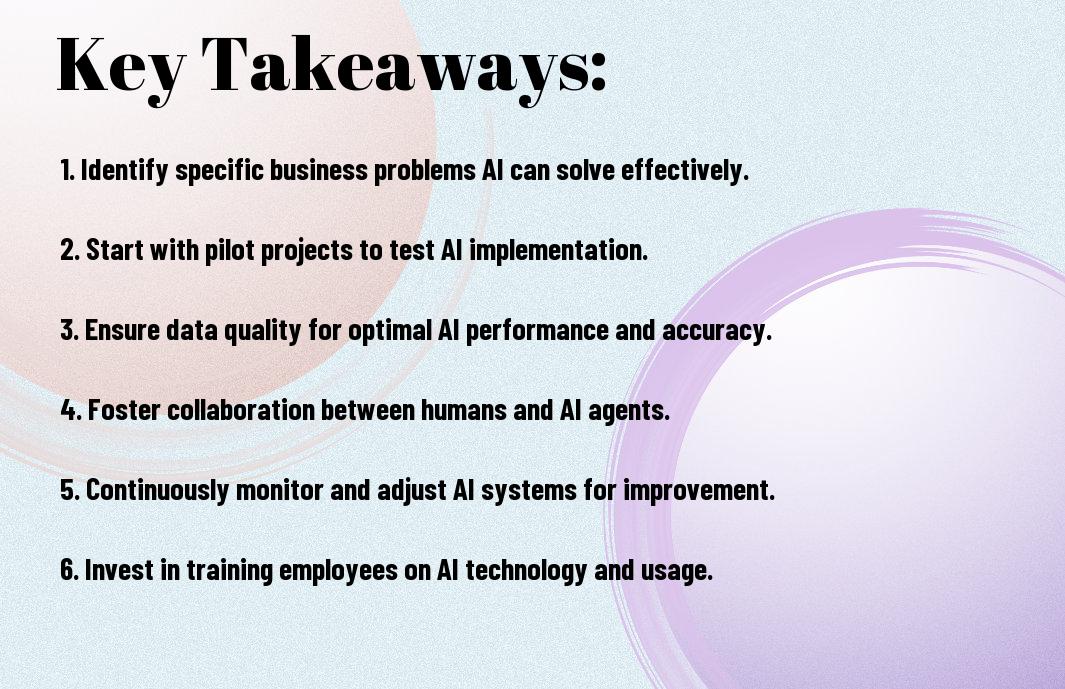As you consider enhancing your business operations, you’re likely exploring the potential of artificial intelligence (AI) to drive growth and efficiency. You’re not alone in this pursuit, as many organizations are now leveraging AI agents to streamline processes and improve customer experiences. By integrating AI into your business model, you can unlock new opportunities and stay competitive in a rapidly evolving market. This post will guide you through the process, providing you with actionable strategies to successfully incorporate AI agents into your operations.
Key Takeaways:
- Identifying the right business processes to automate with AI agents is imperative to maximize efficiency and productivity, allowing companies to focus on high-value tasks that drive growth and innovation.
- Developing a clear understanding of AI agent capabilities and limitations is vital to successful integration, ensuring that businesses can design effective workflows and workflows that complement human skills.
- Continuous monitoring and evaluation of AI agent performance is necessary to refine and improve their effectiveness, enabling businesses to adapt to changing market conditions and customer needs.

The AI Integration Landscape
While navigating the complex world of AI, you’ll need to consider various factors to successfully integrate AI agents into your business model, including the current state of AI technology and its applications, as well as your own business needs and goals.
Current Business AI Applications
Above all, you should be aware of the existing AI applications in your industry, such as chatbots, predictive analytics, and automation, to determine how you can leverage them to enhance your business operations and improve customer experience.
Market Readiness Assessment
Integrating AI into your business requires a thorough assessment of your market readiness, including evaluating your infrastructure, data quality, and employee skills to ensure a smooth transition and maximize the benefits of AI adoption.
And as you conduct your market readiness assessment, you will need to consider factors such as your competitors’ AI adoption, customer expectations, and regulatory requirements to determine the best approach for your business, allowing you to make informed decisions and create a tailored AI integration strategy that meets your unique needs and goals.

Strategic Implementation Framework
You will need to develop a comprehensive strategy for integrating AI agents into your business model, considering factors such as operational efficiency and customer experience.
Technical Infrastructure Requirements
Around the time you start planning, about the technical aspects, you should assess your current infrastructure to determine what upgrades or modifications are necessary to support AI agents.
Resource Allocation Planning
Besides identifying the necessary resources, you should allocate them effectively to ensure a smooth integration process, considering factors such as budget, talent, and timelines.
Also, as you plan your resource allocation, you will need to consider the skills and training required for your team to work effectively with AI agents, as well as the potential need for additional personnel or external partners to support the integration process, and how you will measure the success of your AI integration efforts to inform future decisions and adjustments to your business model.
Employee Integration Protocol
Keep your employees informed about the integration of AI agents into your business model. You can learn more about implementing AI to improve customer service by visiting 8 Ways You Can Implement AI to Improve Customer Service to enhance your understanding.
Training and Skill Development
Teaching your staff about AI agents and their applications is imperative for successful integration. You will need to develop training programs that focus on the skills required to work with AI systems, ensuring your employees are comfortable and confident in their new roles.
Change Management Processes
Across your organization, you will need to establish clear guidelines and protocols for managing change when introducing AI agents. You should communicate the benefits and expectations to your employees, addressing any concerns they may have about the integration process.
The key to successful change management is to be transparent and open with your employees, providing them with the necessary support and resources to adapt to the new technology. You should also establish a feedback mechanism to monitor the progress of the integration and make adjustments as needed, ensuring a smooth transition for your employees and your business.
Risk Management and Compliance
Despite the benefits of AI, you must consider the risks involved, and for that, you can follow 8 steps to successful AI integration to ensure a smooth transition. This will help you identify potential pitfalls and develop strategies to mitigate them, ultimately protecting your business from potential threats.
Security Protocols
Betwixt the various aspects of AI integration, you should prioritize security protocols to safeguard your data and systems from cyber threats, ensuring the integrity of your business operations.
Regulatory Considerations
By understanding the regulatory landscape, you can navigate the complexities of AI integration, ensuring your business remains compliant with relevant laws and regulations, and avoiding potential fines or penalties.
Hence, as you investigate into regulatory considerations, you will need to assess the specific requirements for your industry, such as data protection and privacy laws, and implement measures to ensure your AI systems adhere to these standards, allowing you to maintain trust with your customers and stakeholders, and ultimately, drive business success.
Performance Metrics
Once again, you’ll need to establish a set of performance metrics to evaluate the effectiveness of your AI agents, ensuring they align with your business objectives and contribute to your overall success.
ROI Measurement Systems
Behind every successful AI integration is a robust ROI measurement system, allowing you to track the financial impact of your AI agents and make data-driven decisions to optimize their performance and maximize your return on investment.
Success Indicators
For your AI agents to be considered successful, you’ll need to define key success indicators, such as increased efficiency, enhanced customer experience, or improved decision-making capabilities, which will serve as benchmarks to measure their performance and guide your future investments.
And as you monitor these success indicators, you’ll be able to refine your AI strategy, identifying areas where your agents are excelling and areas where they may need additional training or support, ultimately enabling you to unlock the full potential of your AI-powered business model and drive long-term growth and profitability.
Operational Workflow Design
Not all businesses are ready to integrate AI agents into their workflow, but you can start by assessing your current operations and identifying areas where AI can enhance efficiency. You will need to evaluate your business processes and determine how AI can be incorporated to improve productivity and decision-making.
Process Automation Mapping
Designing an effective automation strategy is key to successful AI integration, and you should begin by mapping out your current processes and identifying areas where automation can add value. You will need to analyze your workflows and determine which tasks can be automated, and how AI can support your business goals.
Human-AI Collaboration Models
Automating tasks is just the first step, and you will also need to consider how your employees will work alongside AI agents. You should design collaboration models that take into account the strengths and weaknesses of both humans and AI, and establish clear guidelines for how they will interact and share tasks.
Indeed, as you develop your human-AI collaboration models, you will need to consider the skills and training your employees will need to effectively work with AI agents. You should provide your staff with the necessary tools and training to ensure they can work efficiently and effectively with AI, and establish a framework for monitoring and evaluating the performance of your human-AI teams. This will enable you to identify areas for improvement and make adjustments as needed to optimize your business operations.
Scaling and Optimization
Now that you have integrated AI agents into your business model, it’s time to focus on scaling and optimization to maximize their potential. You will need to assess your current infrastructure and make adjustments to support the growth of your AI-powered operations.
Growth Strategies
Against the backdrop of increasing competition, you must develop effective growth strategies to stay ahead. You can achieve this by identifying areas where AI can enhance your existing processes and expanding your AI capabilities to new areas of your business.
Continuous Improvement Cycles
Beside the initial implementation, you should prioritize ongoing evaluation and refinement of your AI agents. You will need to monitor their performance, gather feedback, and make data-driven decisions to optimize their impact on your business.
Continuous monitoring and analysis of your AI agents’ performance will help you identify areas for improvement and implement changes to increase their efficiency and effectiveness. You can use this information to adjust your strategies, update your AI models, and ensure that your AI agents continue to drive value for your business, helping you to achieve your goals and stay competitive in the market.
To wrap up
To wrap up, you now have the tools to successfully integrate AI agents into your business model. You can leverage these 8 proven strategies to streamline your operations, enhance customer experience, and drive growth. By implementing these strategies, you will be able to stay ahead of the competition and achieve your business goals. Your business will become more efficient, agile, and innovative, ultimately leading to increased success and profitability.
FAQ
Q: What are the benefits of integrating AI agents into my business model?
A: Integrating AI agents into your business model can bring numerous benefits, including increased efficiency, enhanced customer experience, and improved decision-making. AI agents can automate repetitive tasks, provide 24/7 customer support, and analyze large amounts of data to provide valuable insights. By leveraging AI, businesses can stay competitive, drive innovation, and achieve their goals more effectively.
Q: How can I determine which areas of my business can benefit from AI agents?
A: To determine which areas of your business can benefit from AI agents, start by identifying processes that are repetitive, time-consuming, or prone to errors. Consider areas such as customer service, data analysis, and marketing automation. Assess your business operations and look for opportunities where AI can augment human capabilities, improve accuracy, and enhance productivity. You can also consult with AI experts or conduct a thorough analysis of your business needs to determine the best applications for AI agents.
Q: What are some common challenges businesses face when integrating AI agents into their operations?
A: Common challenges businesses face when integrating AI agents include data quality issues, lack of skilled personnel, and integration with existing systems. Additionally, businesses may struggle with explaining AI-driven decisions, addressing bias in AI algorithms, and ensuring transparency and accountability. To overcome these challenges, it’s crucial to develop a comprehensive AI strategy, invest in employee training, and establish clear guidelines for AI development and deployment.
Q: How can I ensure that my AI agents are transparent and explainable?
A: To ensure that your AI agents are transparent and explainable, prioritize model interpretability and develop techniques to provide insights into AI-driven decisions. This can be achieved by using techniques such as feature attribution, model-agnostic explanations, and transparent model design. Additionally, establish clear guidelines and standards for AI development, and provide training for employees to understand AI-driven decision-making processes. By prioritizing transparency and explainability, businesses can build trust with customers, stakeholders, and regulatory bodies.
Q: What are the key considerations for measuring the success of AI agents in my business?
A: To measure the success of AI agents in your business, establish clear key performance indicators (KPIs) and metrics that align with your business objectives. Monitor metrics such as productivity gains, customer satisfaction, and revenue growth. Regularly assess the performance of AI agents, identify areas for improvement, and adjust your AI strategy accordingly. It’s also crucial to evaluate the return on investment (ROI) of AI initiatives and compare them to traditional methods to ensure that AI agents are delivering expected benefits and driving business value.



